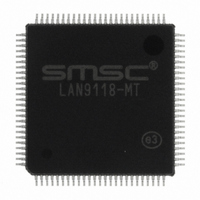LAN9118-MT SMSC, LAN9118-MT Datasheet - Page 64

LAN9118-MT
Manufacturer Part Number
LAN9118-MT
Description
IC ETHERNET CTRLR 10/100 100TQFP
Manufacturer
SMSC
Type
Single Chip MAC and PHYr
Datasheet
1.LAN9118-MT.pdf
(132 pages)
Specifications of LAN9118-MT
Controller Type
Ethernet Controller
Interface
Serial EEPROM
Voltage - Supply
3.3V
Operating Temperature
0°C ~ 70°C
Mounting Type
Surface Mount
Package / Case
100-TQFP, 100-VQFP
Product
Ethernet Controllers
Number Of Transceivers
1
Standard Supported
IEEE 802.3 or IEEE 802.3u
Data Rate
10 Mbps or 100 Mbps
Supply Voltage (max)
3.3 V
Supply Voltage (min)
0 V
Maximum Operating Temperature
+ 70 C
Ethernet Connection Type
100BASE-TX or 10BASE-T
Minimum Operating Temperature
0 C
Mounting Style
SMD/SMT
Lead Free Status / RoHS Status
Lead free / RoHS Compliant
Current - Supply
-
Lead Free Status / Rohs Status
Lead free / RoHS Compliant
Other names
638-1013
Available stocks
Company
Part Number
Manufacturer
Quantity
Price
Company:
Part Number:
LAN9118-MT
Manufacturer:
SMSC
Quantity:
6
Company:
Part Number:
LAN9118-MT
Manufacturer:
Microchip Technology
Quantity:
10 000
Part Number:
LAN9118-MT
Manufacturer:
SMSC
Quantity:
20 000
Company:
Part Number:
LAN9118-MT-E2
Manufacturer:
INTEL
Quantity:
18
Part Number:
LAN9118-MT-E2
Manufacturer:
SMSC
Quantity:
20 000
Revision 1.5 (07-11-08)
4.7
4.7.1
4.7.2
4.7.3
abilities will be advertised. Auto-negotiation can also be disabled via software by clearing register 0,
bit 12.
The LAN9118 does not support “Next Page" capability.
If the LAN9118 is connected to a device lacking the ability to auto-negotiate (i.e. no FLPs are
detected), it is able to determine the speed of the link based on either 100M MLT-3 symbols or 10M
Normal Link Pulses. In this case the link is presumed to be half-duplex per the IEEE standard. This
ability is known as “Parallel Detection. This feature ensures inter operability with legacy link partners.
If a link is formed via parallel detection, then bit 0 in register 6 is cleared to indicate that the Link
Partner is not capable of auto-negotiation. The Ethernet MAC has access to this information via the
management interface. If a fault occurs during parallel detection, bit 4 of register 6 is set.
Register 5 is used to store the Link Partner Ability information, which is coded in the received FLPs.
If the Link Partner is not auto-negotiation capable, then register 5 is updated after completion of parallel
detection to reflect the speed capability of the Link Partner.
Re-starting Auto-negotiation
Auto-negotiation can be re-started at any time by setting register 0, bit 9. Auto-negotiation will also re-
start if the link is broken at any time. A broken link is caused by signal loss. This may occur because
of a cable break, or because of an interruption in the signal transmitted by the Link Partner. Auto-
negotiation resumes in an attempt to determine the new link configuration.
If the management entity re-starts Auto-negotiation by writing to bit 9 of the control register, the
LAN9118 will respond by stopping all transmission/receiving operations. Once the break_link_timer is
done, in the Auto-negotiation state-machine (approximately 1200ms) the auto-negotiation will re-start.
The Link Partner will have also dropped the link due to lack of a received signal, so it too will resume
auto-negotiation.
Disabling Auto-negotiation
Auto-negotiation can be disabled by setting register 0, bit 12 to zero. The device will then force its
speed of operation to reflect the information in register 0, bit 13 (speed) and register 0, bit 8 (duplex).
The speed and duplex bits in register 0 should be ignored when auto-negotiation is enabled.
Half vs. Full-Duplex
Half-duplex operation relies on the CSMA/CD (Carrier Sense Multiple Access / Collision Detect)
protocol to handle network traffic and collisions. In this mode, the carrier sense signal, CRS, responds
to both transmit and receive activity. In this mode, If data is received while the PHY is transmitting, a
collision results.
In full-duplex mode, the PHY is able to transmit and receive data simultaneously. In this mode, CRS
responds only to receive activity. The CSMA/CD protocol does not apply and collision detection is
disabled.
Parallel Detection
Table 4.2
describes the behavior of the CRS bit under all receive/transmit conditions.
DATASHEET
64
High Performance Single-Chip 10/100 Non-PCI Ethernet Controller
SMSC LAN9118
Datasheet














